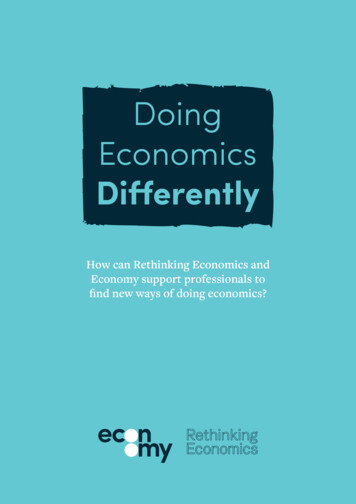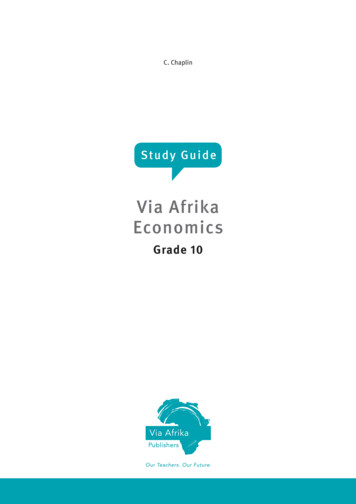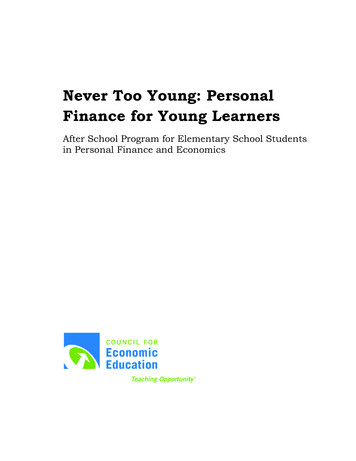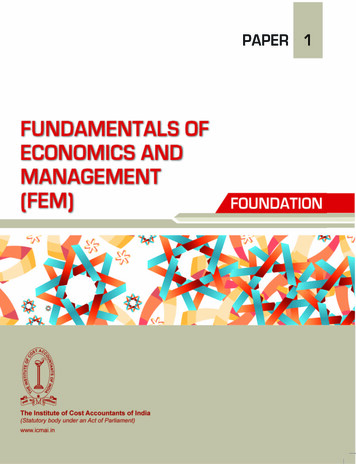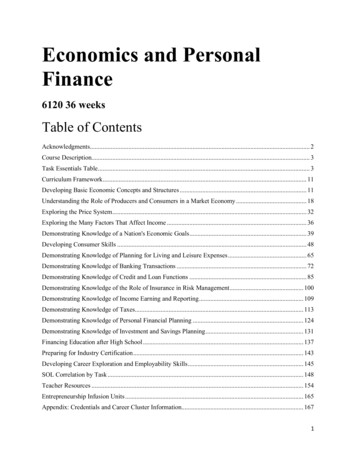
Transcription
Economics and PersonalFinance6120 36 weeksTable of ContentsAcknowledgments. 2Course Description. 3Task Essentials Table . 3Curriculum Framework . 11Developing Basic Economic Concepts and Structures . 11Understanding the Role of Producers and Consumers in a Market Economy . 18Exploring the Price System . 32Exploring the Many Factors That Affect Income . 36Demonstrating Knowledge of a Nation's Economic Goals . 39Developing Consumer Skills . 48Demonstrating Knowledge of Planning for Living and Leisure Expenses . 65Demonstrating Knowledge of Banking Transactions . 72Demonstrating Knowledge of Credit and Loan Functions . 85Demonstrating Knowledge of the Role of Insurance in Risk Management. 100Demonstrating Knowledge of Income Earning and Reporting . 109Demonstrating Knowledge of Taxes. 113Demonstrating Knowledge of Personal Financial Planning . 124Demonstrating Knowledge of Investment and Savings Planning . 131Financing Education after High School . 137Preparing for Industry Certification . 143Developing Career Exploration and Employability Skills . 145SOL Correlation by Task . 148Teacher Resources . 154Entrepreneurship Infusion Units . 165Appendix: Credentials and Career Cluster Information. 1671
AcknowledgmentsThe components of this instructional framework were developed by the following business panelteam members:Amanda Blanks, Investor Education Coordinator, Division of Securities and RetailFranchising, State Corporation Commission, RichmondCherry Hedges, Financial Education Director, Virginia Credit Union, Chesterfield CountyJeffrey Leopold, Associate Director, Darden School of Business, University of Virginia,CharlottesvilleMelissa McCollum, Principal Financial Analyst, Bureau of Financial Institutions, StateCorporation Commission, RichmondKris Moore, Youth Financial Educator, Bayport Credit Union, Newport NewsDan Mortensen, Executive Director, Virginia Council on Economic Education, RichmondKristina Preisner, Director of Education and Executive Director, Independent InsuranceAgents of Virginia, RichmondMelanie Randall, Certified Public Accountant, McKinney & Company, AshlandMarion Rowe, Vice President, Essex Bank, TappahannockRob Shinn, Public Relations and Government Affairs, Capital Results, RichmondJane Watkins, President/CEO, Virginia Credit Union, Chesterfield CountyElizabeth Wiese, Marketing/Business Development Officer, Virginia Educators CreditUnion, Newport NewsThe following teachers served on the teacher writing team:Suzanne Campbell, King William High School, King William County Public SchoolsJoyce Culley, Galileo Magnet High School, Danville Public SchoolsDaniel Dolewski, Fort Chiswell High School, Wythe County Public SchoolsJanice Findley, Chantilly High School, Fairfax County Public SchoolsNicole Glover, Vernon Johns Junior High School, Petersburg City Public SchoolsAndrew Huray, Cave Spring High School, Roanoke County Public SchoolsCourtney Moseley, Greensville County High School, Greensville County Public SchoolsJoy Munsey, Holston High School, Washington County Public SchoolsMichael Onda, James Wood High School, Frederick County Public SchoolsDana Painter, Riverheads High School, Augusta County Public SchoolsTiffanie Smith, Heritage High School, Newport News City Public SchoolsJamyce Watson, Nottoway High School, Nottoway County Public SchoolsThe framework was edited and produced by the CTE Resource Center:Kevin P. Reilly, Administrative Coordinator2
Judith P. Sams, Specialist, Business and Information Technology and Related ClustersOffice of Career and Technical Education ServicesVirginia Department of EducationB. Anne Rowe, CTE Career Cluster CoordinatorOffice of Career and Technical Education ServicesVirginia Department of EducationLolita B. Hall, DirectorOffice of Career and Technical Education ServicesVirginia Department of EducationCopyright 2015Course DescriptionSuggested Grade Level: 10 or 11 or 12Students learn how economies and markets operate and how the United States economy isinterconnected with the global economy. Additionally they learn how to navigate the financialdecisions they must face and to make informed decisions relating to career exploration,budgeting, banking, credit, insurance, spending, financing postsecondary education, taxes, savingand investing, buying/leasing a vehicle, and living independently. They also learn the importanceof investing in themselves in order to gain the knowledge and skills valued in the marketplace.Development of financial literacy skills and an understanding of economic principles willprovide the basis for responsible citizenship, more effective participation in the workforce, andcareer success. The course incorporates all economics and financial literacy objectives includedin the Code of Virginia §22.1-200-03B.Note: As enacted by the General Assembly of 2011 and prescribed by the Board of Education,beginning with students who enter the ninth-grade class for the first time in 2011-2012 andbeyond, all students shall earn one (1) standard credit in Economics and Personal Finance. Allthe Economics and Personal Finance Standards of Learning to meet that graduation requirementfor the Standard and Advanced Studies diplomas are included in the instruction of this course.Task Essentials Table Tasks/competencies designated by plus icons ( ) in the left-hand column(s) are essentialTasks/competencies designated by empty-circle icons ( ) are optionalTasks/competencies designated by minus icons ( ) are omitted3
Tasks marked with an asterisk (*) are ng Basic Economic Concepts and Structures39Describe how consumers, businesses, and government decision-makersface scarcity of resources and must make trade-offs and incuropportunity costs.40Explain that economic choices often have long-term, unintendedconsequences.41Describe how effective decision-making requires comparing theadditional costs (marginal costs) and additional benefits (marginalbenefits).42Identify factors of production.43Compare economic systems.44Explain Adam Smith’s characteristics of a market economy.Understanding the Role of Producers and Consumers in a Market Economy45Describe how consumers, producers, workers, savers, investors, andother people respond to incentives.46Explain how businesses respond to consumer sovereignty.47Identify the role of entrepreneurs.48Compare the costs and benefits of different forms of businessorganization.49Describe how costs and revenues affect profit and supply.50Describe how increased productivity affects costs of production andstandard of living.51Examine how investment in human capital, physical capital, andtechnology can improve productivity.52Describe the effects of competition on producers, sellers, andconsumers.4
53Explain why monopolies or collusion among sellers reducescompetition and raises prices.54Describe the circular flow of economic activity.Exploring the Price System55Examine the laws of supply and demand and the determinants of each.56Explain how the interaction of supply and demand determinesequilibrium price.57Describe the elasticity of supply and demand.58Examine the purposes and implications of price ceilings and pricefloors.Exploring the Many Factors That Affect Income59Examine the market value of a worker’s skills and knowledge.60Describe how changes in supply and demand for goods and servicesaffect a worker’s income.Demonstrating Knowledge of a Nation's Economic Goals61Describe economic indicators, such as gross domestic product (GDP),consumer price index (CPI), and unemployment rate.62Describe the causes and effects of unemployment and inflation.63Describe the fluctuations of the business cycle.64Describe strategies for achieving national economic goals.65Demonstrate knowledge of the nation’s financial system.66Demonstrate knowledge of how monetary and fiscal policy influenceemployment, output, and prices.67Demonstrate knowledge of the role of government in a marketeconomy.68Demonstrate knowledge of the global economy.Developing Consumer Skills5
69Examine basic economic concepts and their relation to product pricesand consumer spending.70Examine the effect of supply and demand on wages and prices.71Describe the steps for making a purchase decision.72Describe common types of contracts and the implications of each.73Demonstrate comparison-shopping skills.74Maintain a filing system for personal financial records.75Examine the impact of advertising and marketing on consumer demandand decision making in the global marketplace.76Access reliable financial information from a variety of sources.77Explain consumer rights, responsibilities, remedies, and the importanceof consumer vigilance.78Examine precautions for protecting identity and other personalinformation.79Interact effectively with salespersons and merchants.80Describe consumer protection regulations.81Describe the role of consumer assistance agencies.Demonstrating Knowledge of Planning for Living and Leisure Expenses82Compare the costs and benefits of purchasing vs. leasing a vehicle.83Compare the advantages and disadvantages of renting vs. purchasing ahome.84Describe the process of renting housing.85Describe the process of purchasing a home.86Calculate the cost of utilities, services, maintenance, and other housingexpenses involved in independent living.87Evaluate discretionary spending decisions.Demonstrating Knowledge of Banking Transactions6
88Describe the types of financial institutions.89Examine how financial institutions affect personal financial planning.90Evaluate services and related costs associated with personal banking.91Differentiate among types and regulations of electronic monetarytransactions.92Prepare all forms necessary for opening and maintaining a checkingand a savings account.93Reconcile bank statements.94Compare costs and benefits of online, mobile, and traditional banking.95Explain how certain historical events have influenced the bankingsystem and other financial institutions.96Compare the U.S. monetary system with the international monetarysystem.Demonstrating Knowledge of Credit and Loan Functions97Evaluate the various methods of financing a purchase.98Analyze credit card features and their impact on personal financialplanning.99Identify qualifications needed to obtain credit.100Identify basic provisions of credit and loan laws.101Compare terms and conditions of various sources of consumer credit.102Identify strategies for effective debt management, including sources ofassistance.103Explain credit rating and credit report.104Compare the costs and conditions of secured and unsecured loans.105Compare the types of voluntary and involuntary bankruptcy and theimplications of each.106Calculate payment schedules for a loan, using spreadsheets, calculators,and/or online tools.7
107Complete a sample credit application.Demonstrating Knowledge of the Role of Insurance in Risk Management108Evaluate insurance as a risk-management strategy.109Distinguish among the types, costs, and benefits of automobileinsurance coverage.110Distinguish among the types, costs, and benefits of life insurance.111Distinguish among the types, costs, and benefits of property insurance.112Distinguish among the types, costs, and benefits of health insurance.113Explain the roles of insurance in financial planning.114Distinguish among the types of professional liability insurance.Demonstrating Knowledge of Income Earning and Reporting115Examine how personal choices about education, training, skilldevelopment, and careers impact earnings.116Differentiate among sources of income.117Calculate net pay.118Investigate employee benefits and incentives.119Complete standard federal employment tax forms.Demonstrating Knowledge of Taxes120Describe the types and purposes of local, state, and federal taxes andthe way each is levied and used.121Explore how tax structures affect consumers, producers, and businessowners differently.122Compute local taxes on products and services.123Examine potential tax deductions and credits on a tax return.124Explain the content and purpose of a standard W-2 and 1099 form.8
125Explain the similarities and differences between state and federaltaxation of inheritances.126Define the terminology associated with inheritance.127Compare investment options for a monetary inheritance.128Examine types and purposes of estate planning.129Complete a state income tax form, including electronic formats.130Complete short and itemized federal income tax forms, includingelectronic formats.Demonstrating Knowledge of Personal Financial Planning131Identify short-term and long-term personal financial goals.132Identify anticipated and unanticipated income and expenses.133Examine components and purposes of a personal net worth statement.134Develop a personal budget.135Investigate the effects of government actions and economic conditionson personal financial planning.136Explain how economics influences a personal financial plan.Demonstrating Knowledge of Investment and Savings Planning137Compare the impact of simple interest vs. compound interest onsavings.138Compare investment and savings options.139Explain costs and income sources for investments.140Examine the fundamental workings of the Social Security System andthe system’s effects on retirement planning.141Contrast alternative retirement plans.142Explore how the stock and bond markets work.Financing Education after High School9
143Identify sources of financial aid.144Examine types of student loans.145Explain the repayment process for student loans.146Describe types of student grants.147Describe types of scholarships.148Describe investment options to pay for college costs.149Identify ways to make the cost of postsecondary education affordable.Preparing for Industry Certification150Describe the process and requirements for obtaining industrycertifications related to the Economics and Personal Finance course.151Identify testing skills/strategies for a certification examination.152Demonstrate ability to successfully complete selected practiceexaminations (e.g., practice questions similar to those on certificationexams).153Successfully complete an industry certification examinationrepresentative of skills learned in this course (e.g., W!SE FinancialLiteracy Examination).Developing Career Exploration and Employability Skills154Investigate career opportunities.155Identify personal interests, aptitudes, and attitudes related to thecharacteristics found in successful workers.156Prepare a professional portfolio.157Research a company in preparation for a job interview.158Participate in mock interviews to refine interviewing techniques.159Legend:Prepare employment-related correspondence.Essential Non-essential Omitted10
Curriculum FrameworkDeveloping Basic Economic Concepts andStructuresTask Number 39Describe how consumers, businesses, and governmentdecision-makers face scarcity of resources and must maketrade-offs and incur opportunity costs.DefinitionDescription should include definitions of the terms resources, scarcity, trade-offs, and opportunity costthe relationships among opportunity cost, trade-offs, resources, and scarcitythe concept that scarcity forces a trade-off and incurs opportunity costs.Economics and Personal Finance Standards of LearningEPF.1The student will demonstrate knowledge of basic economic concepts and structures bya. describing how consumers, businesses, and government decision makers facescarcity of resources and must make trade-offs and incur opportunity costs;b. explaining that choices often have long-term unintended consequences;c. describing how effective decision making requires comparing the additionalcosts (marginal costs) and additional benefits (marginal benefits);d. identifying factors of production;e. comparing the characteristics of market, command, tradition, and mixedeconomies; andf. identifying Adam Smith and describing the characteristics of a marketeconomy.FBLA Competitive Events and Activities AreasAccounting I11
Accounting IIBanking and Financial SystemsBusiness Financial PlanEconomicsEntrepreneurshipThe topic for this event changes from year to year. The annual topic may or may not correlatewith this particular course. Please refer to the current Virginia FBLA State Handbook.Introduction to BusinessPersonal FinanceTask Number 40Explain that economic choices often have long-term,unintended consequences.DefinitionExplanation should include defining unintended consequencesdefining economic choicesgiving examples of unintended consequences of economic choices.Economics and Personal Finance Standards of LearningEPF.1The student will demonstrate knowledge of basic economic concepts and structures bya. describing how consumers, businesses, and government decision makers facescarcity of resources and must make trade-offs and incur opportunity costs;b. explaining that choices often have long-term unintended consequences;c. describing how effective decision making requires comparing the additionalcosts (marginal costs) and additional benefits (marginal benefits);d. identifying factors of production;e. comparing the characteristics of market, command, tradition, and mixedeconomies; and12
f. identifying Adam Smith and describing the characteristics of a marketeconomy.FBLA Competitive Events and Activities AreasAccounting IAccounting IIBanking and Financial SystemsBusiness Financial PlanEconomicsEntrepreneurshipThe topic for this event changes from year to year. The annual topic may or may not correlatewith this particular course. Please refer to the current Virginia FBLA State Handbook.Introduction to BusinessPersonal FinanceTask Number 41Describe how effective decision-making requires comparingthe additional costs (marginal costs) and additional benefits(marginal benefits).DefinitionDescription should include understanding that few choices are all-or-nothing decisionsdefining marginal cost and marginal benefitdefining diminishing marginal utilityexplaining the importance of the marginal cost and marginal benefit of a decision.Economics and Personal Finance Standards of LearningEPF.1The student will demonstrate knowledge of basic economic concepts and structures by13
a. describing how consumers, businesses, and government decision makers facescarcity of resources and must make trade-offs and incur opportunity costs;b. explaining that choices often have long-term unintended consequences;c. describing how effective decision making requires comparing the additionalcosts (marginal costs) and additional benefits (marginal benefits);d. identifying factors of production;e. comparing the characteristics of market, command, tradition, and mixedeconomies; andf. identifying Adam Smith and describing the characteristics of a marketeconomy.FBLA Competitive Events and Activities AreasAccounting IAccounting IIBanking and Financial SystemsBusiness Financial PlanEconomicsEntrepreneurshipThe topic for this event changes from year to year. The annual topic may or may not correlatewith this particular course. Please refer to the current Virginia FBLA State Handbook.Introduction to BusinessPersonal FinanceTask Number 42Identify factors of production.DefinitionIdentification should include definitions of productive resources and economic resourceshuman resources (e.g., labor)natural resources (e.g., land)capital resources (e.g., human, physical)entrepreneurship.14
Economics and Personal Finance Standards of LearningEPF.1The student will demonstrate knowledge of basic economic concepts and structures bya. describing how consumers, businesses, and government decision makers facescarcity of resources and must make trade-offs and incur opportunity costs;b. explaining that choices often have long-term unintended consequences;c. describing how effective decision making requires comparing the additionalcosts (marginal costs) and additional benefits (marginal benefits);d. identifying factors of production;e. comparing the characteristics of market, command, tradition, and mixedeconomies; andf. identifying Adam Smith and describing the characteristics of a marketeconomy.FBLA Competitive Events and Activities AreasAccounting IAccounting IIBanking and Financial SystemsBusiness Financial PlanEconomicsEntrepreneurshipThe topic for this event changes from year to year. The annual topic may or may not correlatewith this particular course. Please refer to the current Virginia FBLA State Handbook.Introduction to BusinessPersonal FinanceTask Number 43Compare economic systems.DefinitionComparison should include15
the purpose of an economic systeman explanation of the three basic economic questionsthe goals and characteristics of market, command, traditional, and mixed economieshow each type of economy answers the three basic economic questions.Economics and Personal Finance Standards of LearningEPF.1The student will demonstrate knowledge of basic economic concepts and structures bya. describing how consumers, businesses, and government decision makers facescarcity of resources and must make trade-offs and incur opportunity costs;b. explaining that choices often have long-term unintended consequences;c. describing how effective decision making requires comparing the additionalcosts (marginal costs) and additional benefits (marginal benefits);d. identifying factors of production;e. comparing the characteristics of market, command, tradition, and mixedeconomies; andf. identifying Adam Smith and describing the characteristics of a marketeconomy.FBLA Competitive Events and Activities AreasAccounting IAccounting IIBanking and Financial SystemsBusiness Financial PlanEconomicsEntrepreneurshipThe topic for this event changes from year to year. The annual topic may or may not correlatewith this particular course. Please refer to the current Virginia FBLA State Handbook.Introduction to BusinessPersonal FinanceTask Number 44Explain Adam Smith’s characteristics of a market economy.16
DefinitionExplanation should include private ownership of resourcesprices determined by marketscompetition among businessesconsumer sovereigntyprofit motivelimited government regulationwhy the market economy is self-regulating.Economics and Personal Finance Standards of LearningEPF.1The student will demonstrate knowledge of basic economic concepts and structures bya. describing how consumers, businesses, and government decision makers facescarcity of resources and must make trade-offs and incur opportunity costs;b. explaining that choices often have long-term unintended consequences;c. describing how effective decision making requires comparing the additionalcosts (marginal costs) and additional benefits (marginal benefits);d. identifying factors of production;e. comparing the characteristics of market, command, tradition, and mixedeconomies; andf. identifying Adam Smith and describing the characteristics of a marketeconomy.FBLA Competitive Events and Activities AreasAccounting IAccounting IIBanking and Financial SystemsBusiness Financial PlanEconomicsEntrepreneurshipThe topic for this event changes from year to year. The annual topic may or may not correlatewith this particular course. Please refer to the current Virginia FBLA State Handbook.Introduction to BusinessPersonal Finance17
Understanding the Role of Producers andConsumers in a Market EconomyTask Number 45Describe how consumers, producers, workers, savers,investors, and other people respond to incentives.DefinitionDescription should define the terms incentive and disincentive and state that people respond to positive and negative incentivesincentives influence people’s behaviorpeople respond to incentives in order to allocate their scarce resources in ways thatprovide the highest possible returns to them.Economics and Personal Finance Standards of LearningEPF.2The student will demonstrate knowledge of the role of producers and consumers in a marketeconomy bya. describing how consumers, producers, workers, savers, investors, and citizensrespond to incentives;b. explaining how businesses respond to consumer sovereignty;c. identifying the role of entrepreneurs;d. comparing the costs and benefits of different forms of business organization,including sole proprietorship, partnership, corporation, franchise, andcooperative;e. describing how costs and revenues affect profit and supply;f. describing how increased productivity affects costs of production and standardof living;g. examining how investment in human capital, capital goods, and technology canimprove productivity;h. describing the effects of competition on producers, sellers, and consumers;18
i. explaining why monopolies or collusion among sellers reduces competition andraises prices; andj. illustrating the circular flow of economic activity.FBLA Competitive Events and Activities AreasAccounting IAccounting IIBanking and Financial SystemsBusiness Financial PlanEconomicsEntrepreneurshipThe topic for this event changes from year to year. The annual topic may or may not correlatewith this particular course. Please refer to the current Virginia FBLA State Handbook.Introduction to BusinessPersonal FinanceTask Number 46Explain how businesses respond to consumer sovereignty.DefinitionExplanation should include a definition of consumer sovereignty and a description of howbusinesses respond to the wishes of consumers in order to succeed.Economics and Personal Finance Standards of LearningEPF.2The student will demonstrate knowledge of the role of producers and consumers in a marketeconomy bya. describing how consumers, producers, workers, savers, investors, and citizensrespond to incentives;b. explaining how businesses respond to consumer sovereignty;c. identifying the role of entrepreneurs;19
d. comparing the costs and benefits of different forms of business organization,including sole proprietorship, partnership, corporation, franchise, andcooperative;e. describing how costs and revenues affect profit and supply;f. describing how increased productivity affects costs of production and standardof living;g. examining how investment in human capital, capital goods, and technology canimprove productivity;h. describing the effects of competition on producers, sellers, and consumers;i. explaining why monopolies or collusion among sellers reduces competition andraises prices; andj. illustrating the circular flow of economic activity.FBLA Competitive Events and Activities AreasAccounting IAccounting IIBanking and Financial SystemsBusiness Financial PlanEconomicsEntrepreneurshipThe topic for this event changes from year to year. The annual topic may or may not correlatewith this particular course. Please refer to the current Virginia FBLA State Handbook.Introduction to BusinessPersonal FinanceTask Number 47Identify the role of entrepreneurs.DefinitionIdentification should include the definition of entrepreneurthe characteristics of an entrepreneurthe entrepreneur’s role in the market economy20
important incentives for entrepreneurshow entrepreneurs benefit society.Economics and Personal Finance Standards of LearningEPF.2The student will demonstrate knowledge of the role of producers and consumers in a marketeconomy bya. describing how consumers, producers, workers, savers, investors, and citizensrespond to incentives;b. explaining how businesses respond to consumer sovereignty;c. identifying the role of entrepreneurs;d. comparing the costs and benefits of different forms of business organization,including sole proprietorship, partnership, corporation, franchise, andcooperative;e. describing how costs and revenues affect profit and supply;f. describing how increased productivit
beyond, all students shall earn one (1) standard credit in Economics and Personal Finance. All the Economics and Personal Finance Standards of Learning to meet that graduation requirement for the




